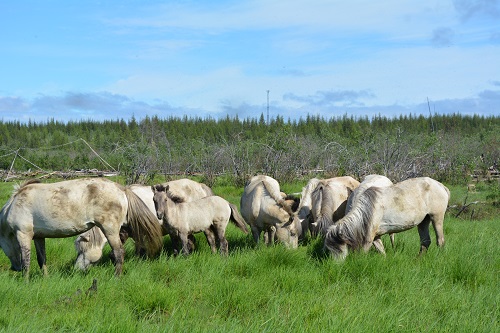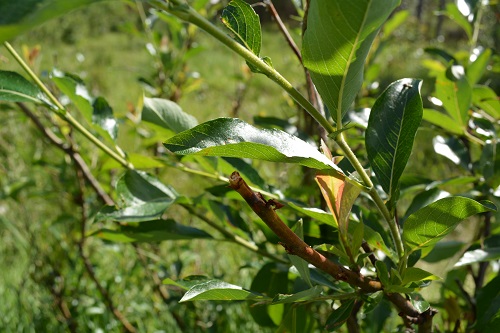There are plenty of natural processes that can change the earth. Tectonic plates move, thrusting seafloors underground and pushing mountains into the sky. Cycles in our orbit around the sun affect any number of atmospheric conditions. Water shapes the earth in the form of rivers carving valleys, glaciers flattening terrain and tearing striae, and currents transporting suspended chemicals around the planet. Given time, plants can break stones with their roots, and they change the makeup of our atmosphere, taking in carbon dioxide and water, emitting oxygen and fixing that carbon into the base of most food webs.
Plants and algae, with their massive coverage of our continents in forests and plains, and clouds of plankton in the ocean, unite the lithosphere (rocks and minerals), hydrosphere, and atmosphere in a giant chemical and energy recycling program that powers the biosphere.
Looking out the window of Orbita, our main laboratory, I can see a few nearby willow shrubs, then nothing but larch- skinny needled trees that look straight out of a Dr. Seuss book for all of their awkwardness. But it wasn’t always this way. Once upon a Pleistocene, this region supported a grassland. Looking out this window into the Pleistocene, just 10,000 years ago, I would see Bering bison, a variety of horses and deer, and even mammoths roaming the grassy steppe.
Where did the mammoths go? The Zimovs will tell you they were overhunted by humans making their way across Asia and North America. We had spears and fire long before we had written language. Some scientists agree, citing the proximity of human migration and large mammals going extinct or disappearing in our paleontological findings. Others disagree, pointing out the remaining animals of the African Savannah, where humans evolved, or time disparities, like the Bering Bison who survived the human onslaught- for a while.
Many in the field still say that it was the shifting climate that eliminated the mammoth, mastodon, and giant sloth along with other Pleistocene megafauna. But the Zimovs think otherwise. They say the megafauna can influence our climate. How? By changing the plant community, at that all important intersection of the earth’s spheres.
Think of African elephants on the savannah, marching by wildebeest moving together in the hundreds of thousands. Or, think of the American bison herds or the prairie, once 50 million strong. Grasslands, or steppes, can support a massive number of megafauna. But it’s a two way street- the megafauna support the grassland. It’s very hard for a tree to shade out grass and reach its adult size if it’s snapped in half every now and then by a sharp hoof. Have you noticed what grows on the side of roads and railways? Grasses are opportunists, they’re excellent at following disturbance. Now think of the disturbance wreaked by 1,500 pounds of bison concentrated into four hooves.

Here, a heard of wild horses grazes and tramples their way across Pleistocene Park.
So what does it matter if we have sparse Siberian larch forest instead of what Sergei and Nikita call the mammoth-steppe ecosystem, full of animals and grass? Avid followers of our blogs will know that there’s more carbon in the frozen soils in the arctic than all of the world’s forests. Soil carbon is pretty hard to digest when it’s totally frozen, but as it thaws, it can be a huge source of food for microbes (sometimes newly thawed ones) eager to grow, reproduce, and respire carbon dioxide. In terms of global warming and our overabundance of CO2 in the atmosphere, we’d like the ground to remain frozen, and the phenomenon of active layer deepening, in which soils can thaw deeper every year, is disturbing.
The Zimovs propose a mechanism by which the mammoth-steppe ecosystem could actually preserve permafrost carbon better than the larch forest. Larch are funny trees, they lose their needles in the winter. They become dark skeletons of trees, not allowing snow to build up in a clean sheet, and absorbing tons of the energy from the light with their dark color. This is in contrast to an animal-rich grassland, in which not only does the snow make a sheet, reflecting away much of the sun’s energy, but it’s trampled by animals. Light snow is an excellent insulator, trampled is not. Under trampled snow, the soil would receive much more of Siberia’s icy chills in the winter, freezing more quickly.

This shrub was browsed by either a Musk ox or Bison.
In addition to the physical characteristics of a steppe that could work against climate change, they propose biological and chemical ones as well. The higher evapotranspiration rates of grass and its own fast growth could mean faster nutrient cycling along the entire ecosystem, and a higher net primary productivity (more carbon taken out of the atmosphere and fixed as plant material).
These are a lot of big ideas, and to test ideas like these we need big minds and big spaces. That’s why just south of here the Zimovs created Pleistocene Park, a 16 square kilometer experiment in ecology and biogeochemistry. Inside the fence live horses, musk ox, moose, and a bison. They’ve worked in and on the park since 1988, expanding and bringing in animals as time allowed. Has the presence of these great animals shifted the park from boreal forest to the grassland? Can animal reintroductions slow greenhouse gas emissions from the arctic?
The stage is set; stick around for part II to hear how I’ve aimed to answer these questions.



